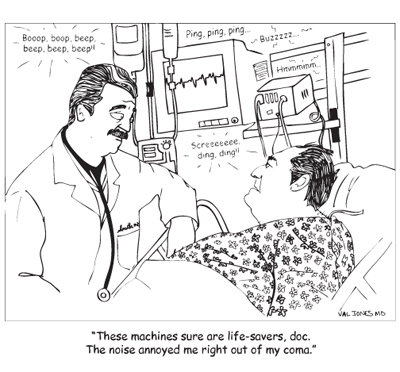September 4th, 2011 by Toni Brayer, M.D. in Opinion, Research
No Comments »

 Hospitals across the country are working on quality initiatives to reduce re-admissions to hospitals. There are consultants, conferences, forums, meetings, physicians, nurses and administrators who are spending hours upon hours (and lots of $$$) to find ways to keep patients who have been discharged from being readmitted within 30 days. Why all of this activity? It is one of the quality measures that is being tracked by Medicare and Medical (CMS) and decreased reimbursement will be next if a patient is readmitted to any hospital within 30 days of a discharge. The diagnosis doesn’t matter.
Hospitals across the country are working on quality initiatives to reduce re-admissions to hospitals. There are consultants, conferences, forums, meetings, physicians, nurses and administrators who are spending hours upon hours (and lots of $$$) to find ways to keep patients who have been discharged from being readmitted within 30 days. Why all of this activity? It is one of the quality measures that is being tracked by Medicare and Medical (CMS) and decreased reimbursement will be next if a patient is readmitted to any hospital within 30 days of a discharge. The diagnosis doesn’t matter.
A new study shows all of this focus and cost may not be worth it. Readmission after a hospital discharge may not be an indication of poor care.
The study, published in the Canadian Medical Association Journal looked at 4,812 patients and had medical experts review the cases of the 649 who needed urgent readmission within 6 months. (Not one month as we are measuring). They found that Read more »
*This blog post was originally published at EverythingHealth*
January 11th, 2011 by admin in Health Tips
1 Comment »
 This is a guest post from Dr. Anita Gupta.
This is a guest post from Dr. Anita Gupta.
**********
How To Have A Pain-Free Hospital Stay
Too often patients feel like they’re in the passenger seat when entering the hospital. Even in the best of circumstances — such as planned admissions — patients often don’t feel in control of their own care.
One of the most unnecessary issues facing patients when they enter the hospital is untreated (or undertreated) pain. Often the focus of the medical team is to treat a condition, and controlling a patient’s pain comes second. Fortunately, this doesn’t need to be the situation. Here are a few tips for patients to ensure that their pain does not go overlooked:
— Let someone know if you are in pain. This may seem obvious, but patients often hesitate to question their doctor. Pain control during your hospital stay is not a luxury, and you need to know you have a right to pain control during your stay. If you doctor or nurse is not answering your questions regarding pain, ask to see pain specialist who will likely address your concerns as well as the concerns of the doctors and nurses taking care of you. Unfortunately when it comes to treating pain, not all doctors are trained equally.
— Have a family member or good friend to act as your advocate. Have this individual get involved in your medical care and act on your behalf during your hospitalization. Read more »
November 20th, 2010 by KevinMD in Better Health Network, Health Policy, News, Research
No Comments »

Hospitals have recently been stepping up their infection control procedures, in the wake of news about iatrogenic infections afflicting patients when they are admitted. Doctors are increasingly wearing a variety of protective garb — gowns, gloves, and masks — while seeing patients.
In an interesting New York Times column, Pauline Chen wonders how this affects the doctor-patient relationship. She cites a study from the Annals of Family Medicine, which concluded that,
fear of contagion among physicians, studies have shown, can compromise the quality of care delivered. When compared with patients not in isolation, those individuals on contact precautions have fewer interactions with clinicians, more delays in care, decreased satisfaction and greater incidences of depression and anxiety. These differences translate into more noninfectious complications like falls and pressure ulcers and an increase of as much at 100 percent in the overall incidence of adverse events.
Hospitals are in a no-win situation here. On one hand, they have to do all they can to minimize the risk of healthcare-acquired infections, but on the other, doctors need to strive for a closer bond with patients — which protective garb sometimes can impede. Read more »
*This blog post was originally published at KevinMD.com*
 Hospitals across the country are working on quality initiatives to reduce re-admissions to hospitals. There are consultants, conferences, forums, meetings, physicians, nurses and administrators who are spending hours upon hours (and lots of $$$) to find ways to keep patients who have been discharged from being readmitted within 30 days. Why all of this activity? It is one of the quality measures that is being tracked by Medicare and Medical (CMS) and decreased reimbursement will be next if a patient is readmitted to any hospital within 30 days of a discharge. The diagnosis doesn’t matter.
Hospitals across the country are working on quality initiatives to reduce re-admissions to hospitals. There are consultants, conferences, forums, meetings, physicians, nurses and administrators who are spending hours upon hours (and lots of $$$) to find ways to keep patients who have been discharged from being readmitted within 30 days. Why all of this activity? It is one of the quality measures that is being tracked by Medicare and Medical (CMS) and decreased reimbursement will be next if a patient is readmitted to any hospital within 30 days of a discharge. The diagnosis doesn’t matter.


 This is a guest post from Dr. Anita Gupta.
This is a guest post from Dr. Anita Gupta.








